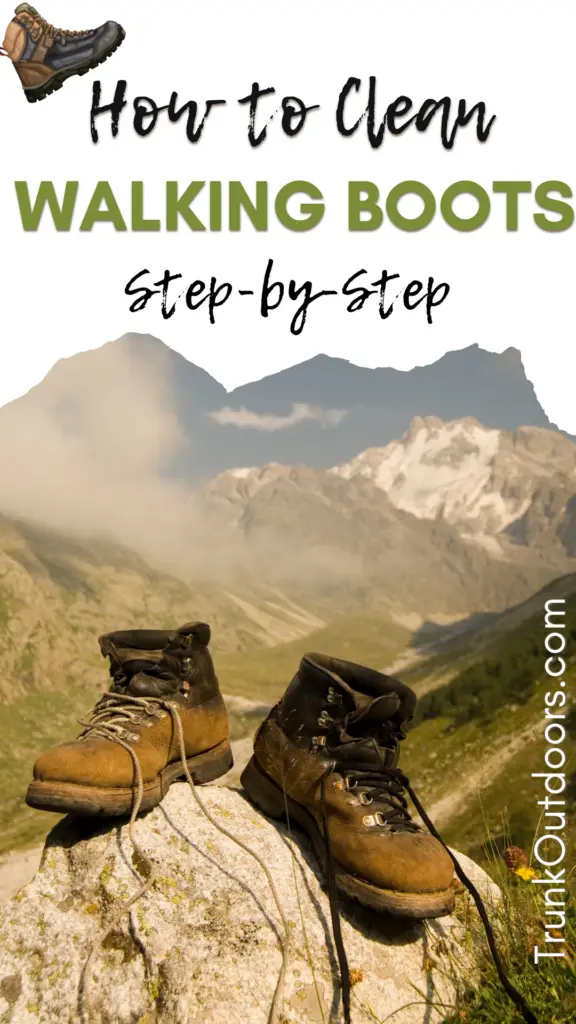How to Clean Your Walking Boots and Shoes
Walking boots and shoes are not just footwear; they are companions on your outdoor adventures, offering comfort and protection.
As a seasoned camper with vast experience in diverse environments, I know that proper cleaning and care of walking boots is important to extend their lifespan and prevent damage.
Let’s dive into how to clean your walking boots and shoes to ensure they stand the test of time across various terrains.

1. Initial Cleaning
After each outdoor excursion, your boots or shoes may be caked with dirt, mud, and debris. Allow any excess mud to dry before brushing it off with a stiff-bristled brush.
In my camping journeys, I’ve found this prevents further embedding of mud.
For leather boots, I recommend using a mild soap and water solution for gentle cleaning, ensuring not to saturate the leather.
Synthetic materials can benefit from a specialized footwear cleaner. Harsh detergents or bleach are a no-go, as they can compromise material integrity and waterproofing.
2. Deep Cleaning
For stubborn dirt and grime, a deeper cleaning is necessary.
Remove laces and insoles, washing them separately in warm, soapy water. As I’ve learned over the years, this ensures a thorough clean.
For the boots or shoes themselves, consider a specialized footwear cleaning solution or a mixture of mild soap and warm water.
- Use a soft-bristled brush, paying attention to dirt-prone areas like seams and soles.
- Rinse thoroughly to remove any soap residue.
3. Drying and Conditioning
Proper drying is crucial to prevent mold and maintain shape.
Stuff your boots or shoes with newspaper to absorb moisture and help them retain their form.
I advise against using direct heat sources to dry boots, such as hair dryers, open fires, or radiators, which can damage materials. Try convection-style boot dryers or natural air drying. Also, don’t let walking boots sit wet for a long time, as Gore-Tex states.
4. Re-proofing your walking boots
Re-proofing your walking boots is an essential part of maintaining their durability and performance. Leather and synthetic boots require different re-proofing methods.
Before you start, make sure your boots are clean and dry. Use a soft brush to remove any dirt or debris.
To re-proof leather boots, apply a thin layer of Nikwax Leather Conditioner to the boots. Be sure to work the conditioner into all the nooks and crannies. Let the conditioner dry completely. Once the conditioner is dry, apply a waterproofing spray to the boots.
For synthetic boots, apply Nikwax Fabric and Leather Proof to the boots.
Pro Tip: Follow the instructions on the product label. Be sure to apply the spray evenly to all the surfaces of the boots. Let the waterproofing spray dry completely.
Tips to care for walking boots
Regular cleaning will help to remove dirt and grime, which can build up and damage the material of your boots. Deep cleaning every few months will help to remove stubborn dirt and grime, and also condition the material of your boots.
Proper storage is important to prevent mold and mildew growth. Store your boots in a cool, dry place, away from direct sunlight and extreme temperatures.
Washing your laces and replacing insoles as needed will help to keep your boots comfortable and supportive.
If your boots are heavily soiled or damaged, you may consider professional cleaning services.
The Importance of Properly Maintaining Walking Boots
If walking boots are not properly maintained, they can become damaged and require replacement sooner than necessary.
Dirt and grime can build up and cause the material of the boots to break down. Mold and mildew growth can also damage the boots and cause them to smell. Additionally, if the laces or insoles are not replaced as needed, they can wear out and cause discomfort.
In addition to the potential damage to the boots themselves, not maintaining walking boots can also lead to safety hazards. For example, if the soles of the boots are worn down, they may not provide enough traction, which can increase the risk of slips and falls.
Additionally, if the boots are not properly waterproofed, they may allow moisture to enter, which can cause blisters and other foot problems.
Final Thoughts
By following these simple cleaning and maintenance guidelines, you can ensure that your walking boots or shoes remain in top condition for years to come, providing you with the comfort, protection, and performance you need for all your outdoor adventures.
Share your camping wisdom and tips in the comments below. Let’s build a community of outdoor enthusiasts committed to maintaining their gear for countless adventures!
You may also like: